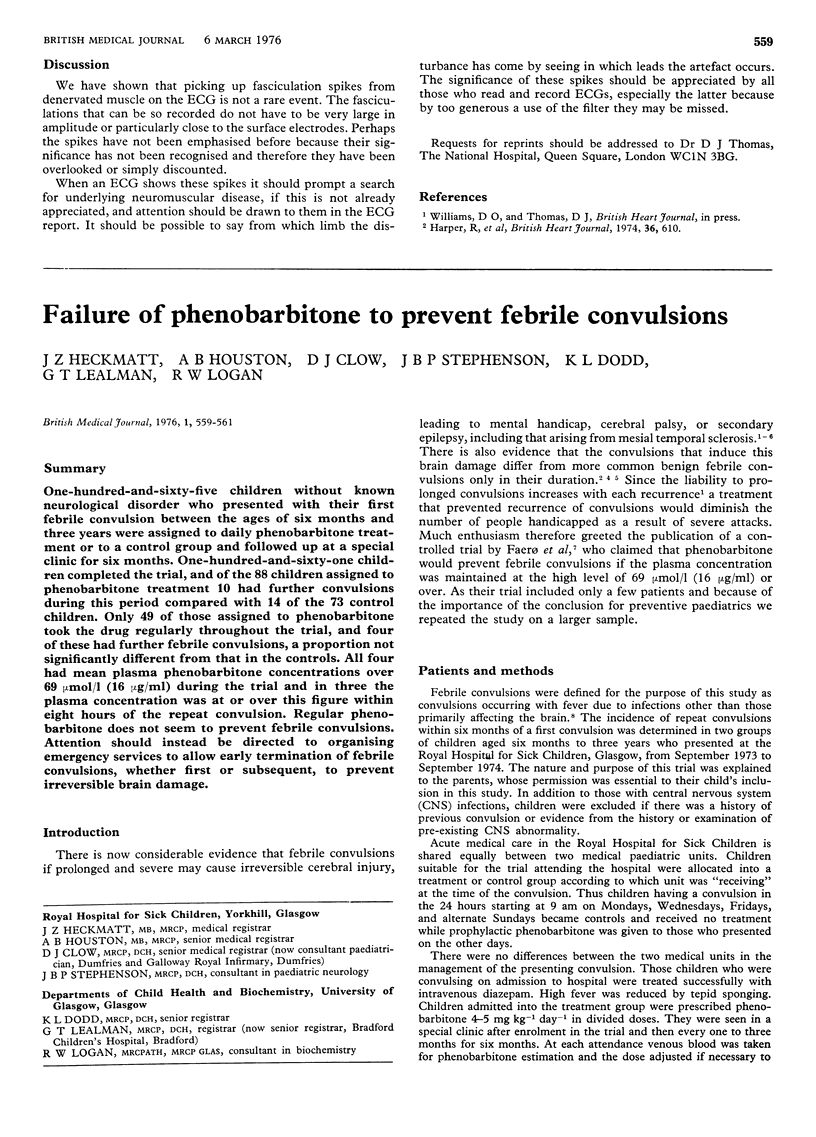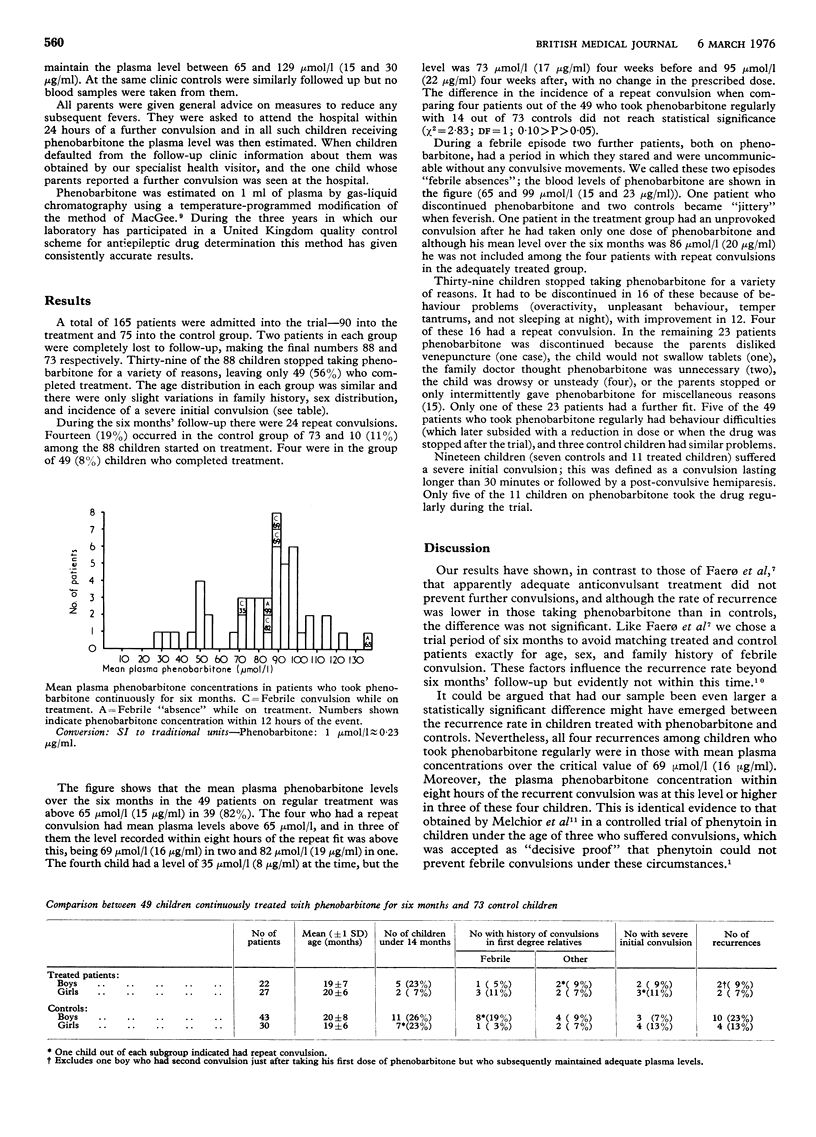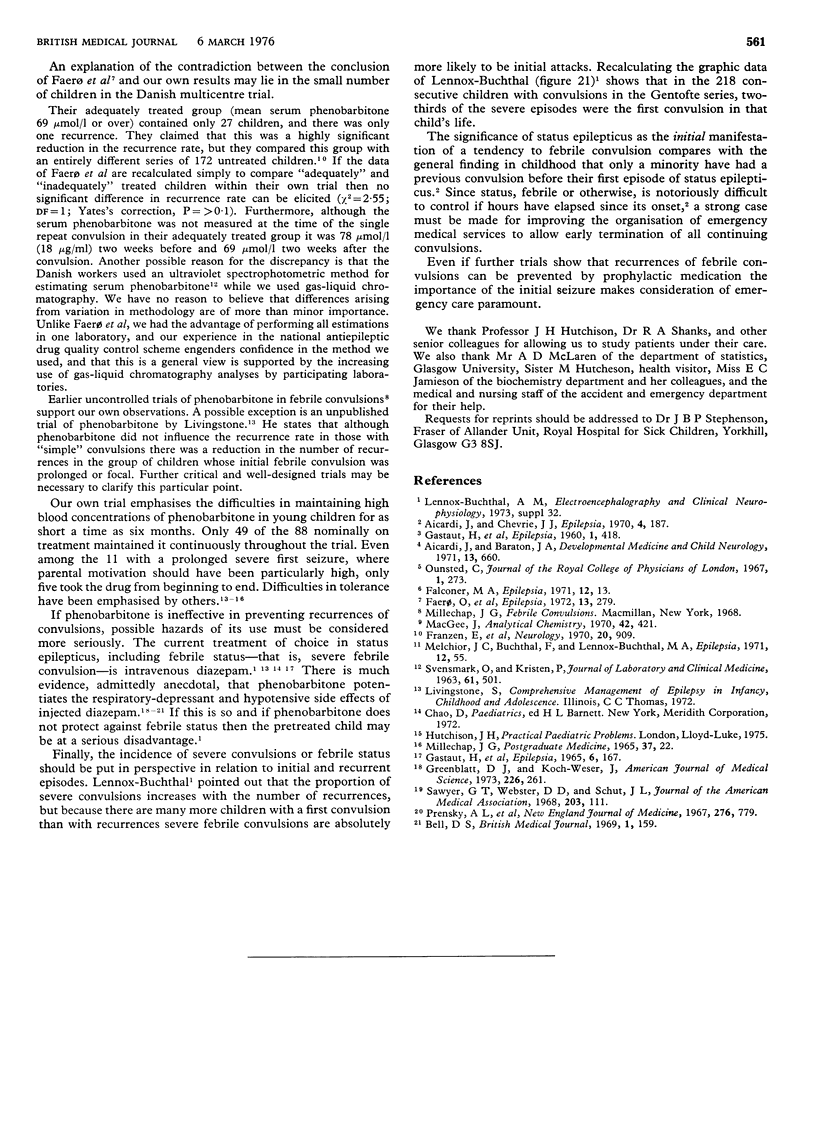Abstract
One-hundred-sixty-five children without known neurological disorder who presented with their first febrile convulsion between the ages of six months and three years were assigned to daily phenobarbitone treatment or to a control group and followed up at a special clinic for six months. One-hundred-and-sixty-one-one children completed the trial, and of the 88 children assigned to phenobarbitone treatment 10 had further convulsions during this period compared with 14 of the 73 control children. Only 49 of those assigned to phenobarbitone took the drug regularly throughout the trial, and four of these had further febrile convulsions, a proportion not significantly different from that in the controls. All four had mean plasma phenobarbitone concentrations over 69 mumol/l (16 mug/ml) during the trial and in three the plasma concentration was at or over this figure within eight hours over 69 mumol/l (16 mug/ml) during the trial and in three the plasma concentration was at or over this figure within eight hours of the repeat convulsion. Regular phenobarbitone does not seem to prevent febrile convulsions. Attention should instead be directed to organising emergency services to allow early termination of fevrile convulsions, whether first or subsequent, to prevent irreversible brain damage.
Full text
PDF


Selected References
These references are in PubMed. This may not be the complete list of references from this article.
- Aicardi J., Baraton J. A pneumoencephalographic demonstration of brain atrophy following status epilepticus. Dev Med Child Neurol. 1971 Oct;13(5):660–667. doi: 10.1111/j.1469-8749.1971.tb08333.x. [DOI] [PubMed] [Google Scholar]
- Aicardi J., Chevrie J. J. Convulsive status epilepticus in infants and children. A study of 239 cases. Epilepsia. 1970 Jun;11(2):187–197. doi: 10.1111/j.1528-1157.1970.tb03880.x. [DOI] [PubMed] [Google Scholar]
- Cain J. C. Selective service and military medical manpower. JAMA. 1968 Jan 8;203(2):111–112. [PubMed] [Google Scholar]
- Faero O., Kastrup K. W., Lykkegaard Nielsen E., Melchior J. C., Thorn I. Successful prophylaxis of febrile convulsions with phenobarbital. Epilepsia. 1972 Apr;13(2):279–285. doi: 10.1111/j.1528-1157.1972.tb05262.x. [DOI] [PubMed] [Google Scholar]
- Falconer M. A. Genetic and related aetiological factors in temporal lobe epilepsy. A review. Epilepsia. 1971 Mar;12(1):13–31. doi: 10.1111/j.1528-1157.1971.tb03912.x. [DOI] [PubMed] [Google Scholar]
- Frantzen E., Lennox-Buchthal M., Nygaard A., Stene J. A genetic study of febrile convulsions. Neurology. 1970 Sep;20(9):909–917. doi: 10.1212/wnl.20.9.909. [DOI] [PubMed] [Google Scholar]
- GASTAUT H., NAQUET R., POIRE R., TASSINARI C. A. TREATMENT OF STATUS EPILEPTICUS WITH DIAZEPAM (VALIUM). Epilepsia. 1965 Jun;6:167–182. doi: 10.1111/j.1528-1157.1965.tb03786.x. [DOI] [PubMed] [Google Scholar]
- Greenblatt D. J., Koch-Weser J. Adverse reactions to intravenous diazepam: a report from the Boston Collaborative Drug Surveillance Program. Am J Med Sci. 1973 Oct;266(4):261–266. [PubMed] [Google Scholar]
- MILLICHAP J. G. ANTICONVULSANT DRUGS. CLINICAL AND ELECTROENCEPHALOGRAPHIC INDICATIONS, EFFICACY AND TOXICITY. Postgrad Med. 1965 Jan;37:22–34. doi: 10.1080/00325481.1965.11695393. [DOI] [PubMed] [Google Scholar]
- MacGee J. Rapid determination of diphenylhydantoin in blood plasma by gas-liquid chromatography. Anal Chem. 1970 Mar;42(3):421–422. doi: 10.1021/ac60285a024. [DOI] [PubMed] [Google Scholar]
- Melchior J. C., Buchthal F., Lennox-Buchthal M. The ineffectiveness of diphenylhydantoin in preventing febrile convulsions in the age of greatest risk, under three years. Epilepsia. 1971 Mar;12(1):55–62. doi: 10.1111/j.1528-1157.1971.tb03915.x. [DOI] [PubMed] [Google Scholar]
- Prensky A. L., Raff M. C., Moore M. J., Schwab R. S. Intravenous diazepam in the treatment of prolonged seizure activity. N Engl J Med. 1967 Apr 6;276(14):779–784. doi: 10.1056/NEJM196704062761404. [DOI] [PubMed] [Google Scholar]


